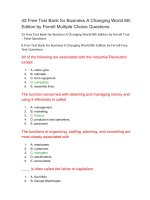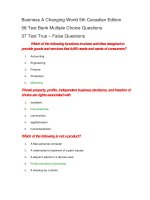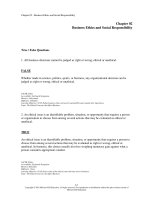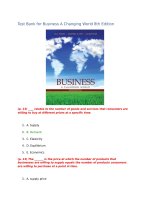Business a changing world 7e by ferrell chap003
Bạn đang xem bản rút gọn của tài liệu. Xem và tải ngay bản đầy đủ của tài liệu tại đây (2.59 MB, 46 trang )
Business in a
Changing World
Chapter 3
Business in a Borderless
World
McGraw-Hill/Irwin
Copyright © 2009 by the McGraw-Hill Companies, Inc. All rights
3-3
Fresh & Easy Grocery -Shopping for One & All!
Tesco, the UK grocery giant, has developed the
Neighborhood Market that is making its way into
U.S. communities. Affordable and wholesome food
is the core competency for Tesco.
3-4
International Business
We live in a global economy -- consumers around
the world drink Coca-Cola, Pepsi, and eat at
McDonalds. Products you consume today are just
as likely to have been made in China, Korea or
Germany as in the United States.
3-5
International Business
International business – the buying, selling, and
trading of goods and services across national
boundaries.
3-6
International Business
Globalization of business is becoming
increasingly important
Starbucks serves 20 million customers a week at
16,000 shops in 44 countries.
Global marketing requires balancing global
brands with the needs of local consumers.
3-7
Why Nations Trade
International trade allows for the
acquisition of raw materials and goods
at favorable prices.
Absolute advantage – a monopoly that exists
when a country is the only source of an item, the
only producer of an item, or the most efficient
producer of an item.
3-8
Why Nations Trade
International trade allows for the
acquisition of raw materials and goods
at favorable prices.
Comparative advantage – the basis of most
international trade, when a country specializes in
products that it can supply more efficiently or at
a lower cost than it can produce other items.
3-9
Why Nations Trade
International trade allows for the
acquisition of raw materials and goods
at favorable prices.
Outsourcing – the transferring of manufacturing
or other tasks—such as data processing—to
countries where labor and supplies are less
expensive.
3-10
Trade Between Countries
Obtaining needed goods and services
and the funds to pay for them,
requires international trade through
exporting and importing.
Exporting – the sale of goods and services to
foreign markets.
The U.S. exported more than $1.6 trillion in goods and services last year.
3-11
Trade Between Countries
Obtaining needed goods and services
and the funds to pay for them,
requires international trade through
exporting and importing.
Importing – the purchase of goods and services
from foreign sources.
The U.S. imported more than $2.3 trillion in goods/services last year
3-12
Balance of Trade
The difference in the value
between what a nation
exports and imports is its
balance of trade.
U.S. Trade Deficit
1980-2006
(in billions of dollars)
A trade deficit
(shown in the
table) shows that
the U.S. has a
trade deficit – it
imports more
than it exports.
A trade deficit is also called a
nation’s negative balance of
trade.
3-13
Balance of Trade
U.S. Exports to China Increase
Trade deficits are harmful – failure of businesses, loss of jobs, lowered standard of living.
3-14
Balance of Trade
Top 10 Countries Maintaining
Trade Deficits/Surpluses with the U.S.
3-15
International Trade Barriers
A nation’s balance of trade, foreign
investments, foreign aid, loans,
tourists dollars, and military
expenditures comprise its balance of
payments
Balance of payments – the difference between
the flow of money into and out of a country.
3-16
International Trade Barriers
Completely free trade seldom exists.
Barriers to International Trade –
•Economic
•Legal
•Political
•Social
•Cultural
•Technological
3-17
International Trade Barriers
ECONOMIC BARRIERS.
•Economic development
•Infrastructure
•Exchange rates
3-18
International Trade Barriers
Economic Development
LDC’s – less-developed countries
•Low per-capita income
•Less economically advanced
•Potentially huge & profitable markets
3-19
International Trade Barriers
Infrastructure
The physical facilities that support economic
activities, including railroads, highways, ports,
airfields, utilities, power plants, schools,
hospitals, and commercial distribution systems.
3-20
International Trade Barriers
Exchange Rates
The ratio at which one nation’s currency can be
exchanged for another nation’s currency.
3-21
International Trade Barriers
Ethical, Legal, and Political Barriers.
•Complex relationships
•Different laws
•International laws
•Trade restrictions
•Changing political climates
•Different ethical values
3-22
International Trade Barriers
Tariffs & Trade Restrictions
Part of a nation’s legal structure – may be
established or removed for political reasons.
Import Tariff – a tax levied by a nation on goods
imported into the country
3-23
International Trade Barriers
Tariffs & Trade Restrictions
Exchange controls – regulations that restrict the
amount of currency that can be bought or sold
Quota – a restriction on the number of units of a
particular product that can be imported into a
country
3-24
International Trade Barriers
Tariffs & Trade Restrictions
Embargo– a prohibition on trade in a particular
product
Dumping – the act of a country or business selling
products at less than what it costs to produce them
3-25









